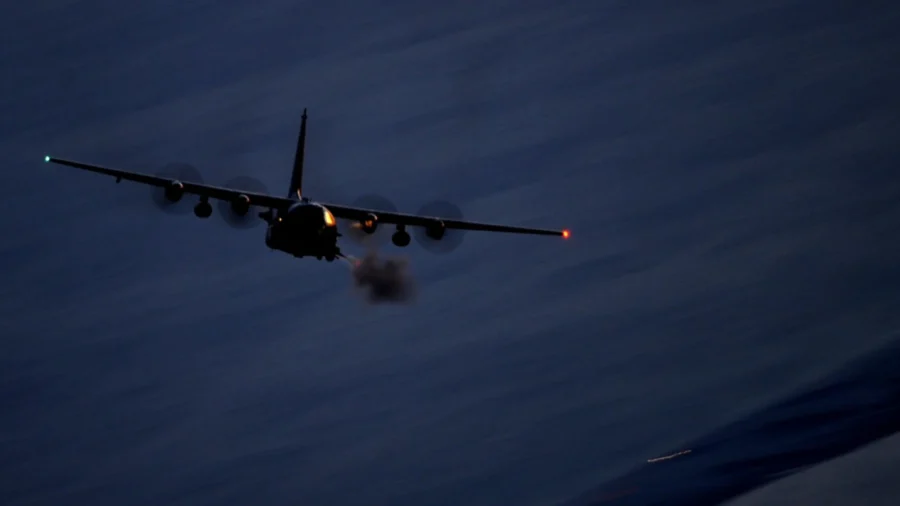A U.S. AC-130 gunship carried out strikes on suspected militants in Iraq on Monday evening, in response to a missile attack targeting U.S. forces in Iraq.
In an emailed statement, the U.S. Central Command (CENTCOM) told NTD News that the Ain Al-Asad Airbase in western Baghdad came under attack from suspected Iran-backed militias on Monday evening. A CENTCOM spokesperson said the Iran-backed militia members launched a “close-range ballistic missile” at U.S. and Coalition forces stationed at the Iraqi airbase, injuring eight people and inflicting “some minor damage” on the base’s infrastructure.
The attack on Ain Al-Asad Airbase marks the 66th time U.S. forces in Iraq and Syria have come under attack. In total, at least 62 U.S. personnel have been injured across 32 separate attacks in Iraq and 34 in Syria since Oct. 17.
The CENTCOM spokesperson said U.S. forces immediately responded to the attack on the Ain Al-Asad Airbase by directing an AC-130 gunship in the area to fire upon the suspected attackers. The military command said the U.S. aircraft hit a vehicle used by the suspected Iran-backed militia members and struck several suspected militia fighters involved in the short-range missile attack.
The Monday AC-130 strike marks the fourth time since Oct. 17 that U.S. aircraft have carried out an armed response to attacks on U.S. positions in Iraq and Syria. In the first three cases, U.S. aircraft targeted suspected Iranian-linked personnel and facilities throughout Syria on Oct. 26, Nov. 8, and Nov. 12. The Monday evening strike marks the first time since Oct. 17 that U.S. forces have specifically targeted Iranian-linked militia fighters within Iraq.
Airstrikes Meant as Deterrent
At a Tuesday press briefing, Pentagon deputy press secretary Sabrina Singh said the three prior U.S. airstrikes in Syria were preplanned operations, while the Monday evening strike was not.
“We were able to identify the point of origin of these attacks because an AC-130 was already in the area and therefore was able to respond,” Ms. Singh explained.
Of the 66 attacks on U.S. forces in Iraq and Syria, most have seen attackers launch rocket barrages and remotely pilot explosive-laden one-way drones toward known U.S. positions. Ms. Singh said the Monday attack on the Ain Al-Asad Airbase represents the first time since Oct. 17 that U.S. forces have specifically been targeted with a ballistic missile. She did not provide any additional details about the type of ballistic missile employed in the Monday evening attack.
The recent pattern of suspected Iran-backed militia attacks on U.S. forces in Iraq and Syria coincides with fighting between Israel and Hamas after Hamas gunmen attacked Israel on Oct. 7.
The United States has supported Israel’s military over the years and U.S. lawmakers are currently considering legislation to allocate an additional $14 billion in military resources for the country. On the other hand, the United States has long suspected Iran of providing weapons, training, and funding to numerous factions throughout the Middle East, such as Hamas.
Ms. Singh has said the four recent U.S. airstrikes in the Middle East have been conducted with the intent to deter additional attacks on U.S. forces. While attacks on U.S. forces have continued since the first U.S. airstrike on Oct. 26, Ms. Singh pushed back on suggestions that the U.S. strikes are not having a deterring effect and suggested the U.S. response strikes have been at an appropriate level for the damage and injuries U.S. forces have sustained since Oct. 17.
“I wouldn’t say that, again, it’s not working. I would say that we are being very deliberate in our strikes and what we target,” Ms. Singh said during the Tuesday press briefing.
Ms. Singh said the injuries sustained by U.S. forces in Iraq and Syria have been “non-serious” and the damage to U.S. equipment and infrastructure has been “minor,” whereas the U.S. side has destroyed a suspected weapons cache, a command base, a training facility, and now a vehicle and combatants linked to Iran-backed militia factions.


